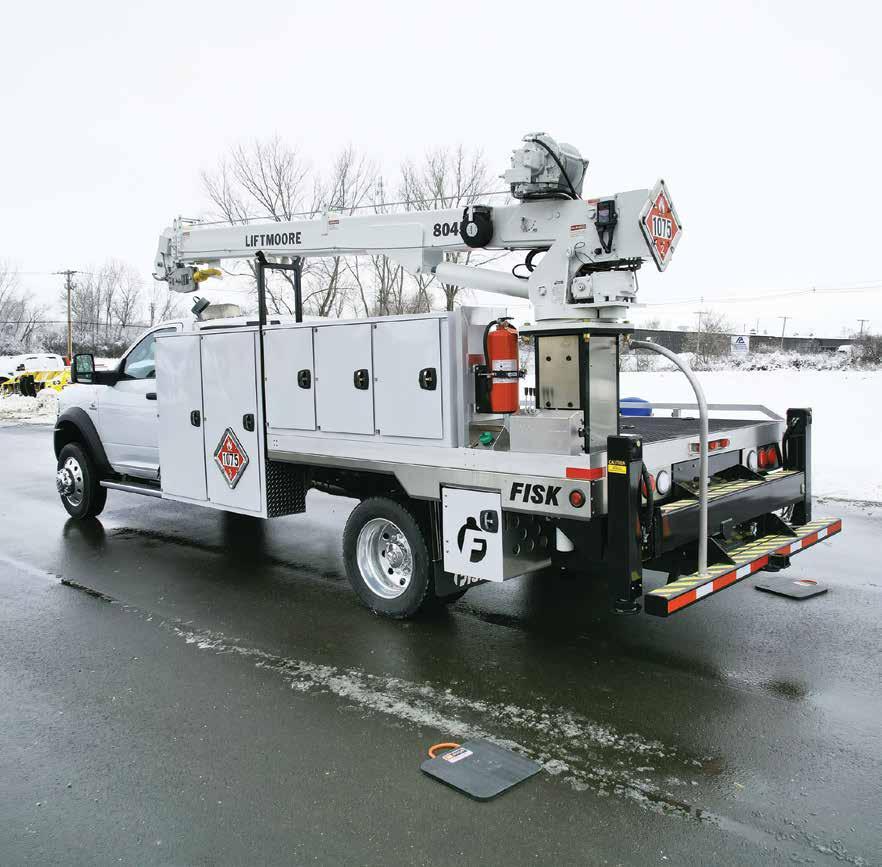Texas Propane Texas Propane Texas Propane



This nascent industry in Texas requires massive energy. Propane could play a bigger role as it encounters growing pains.
This nascent industry in Texas requires massive energy. Propane could play a bigger role as it encounters growing pains.
Powering Tomorrow:
The Resurgence of Propane Fuel Cells
Changing the Game in Power Generation & Propane EV Charging








This month, we dive into an interesting conversation about the massive power needs of the Texas crypto mining industry. Our state, with its abundant natural resources and business-friendly regulations, has become one of the industry’s prime destinations. The current estimate is that Texas is home to 40 percent of the United States’ and 17 percent of global mining operations.
These are big numbers; and these companies use big-time electricity.
Propane is already being used by some of these players, but perhaps there’s a bigger role in our future. Things in this field are changing quickly, and you should be ready to pivot and capitalize if more comes your way.
We are also including a story about the resurgence of propane fuel cells (page 12). As backup power becomes more and more a necessity, a propane fuel cell is a great solution to replace diesel generators. They are cleaner, quieter, consume less fuel and are compatible with batteries and solar installations.
Another way propane is used as an “electric” source is in the EV charging industry (page 18). Propane can either be used in a mobile power generation situation (i.e. an EV powered vehicle has run out of juice and needs a “jump”) or in remote areas, like wildfire-prone locations in California.
It’s fun seeing where our industry has been. Take a look at the “A Look Back: 1955” on page 16, when the world was much concerned about withstanding a nuclear attack. Interestingly enough, the propane infrastructure held up well in their testing.
Make sure you’ve marked August 1-3 on your calendars for the 2024 Crossroads Expo + Conference in Allen. It is always important to learn from each other, invest in education, and maybe raise a few glasses.
TPGA staff
Bill Van Hoy ................. bvanhoy@txpropane.com Executive Director
Jackie Mason................... jmason@txpropane.com Education & Marketing Director Regulatory & Sr. Legislative Affairs Director
Julie Novinger...........accountant@txpropane.com Bookkeeper
Soo Teal ................................ steal@txpropane.com Membership & Meeting Manager
Propane Service Corporation
Soo Teal..sales@propaneservicecorp.com Manager 800-392-0023
Publisher Kim Scheberle ............. kscheberle@austin.rr.com Account Manager/Managing Editor
Sail House Publishing 512-346-0892
Joanne Pantaze ................. jpantaze@zochnet.com Advertising Sales 512-273-2639
Kiki Pantaze ....................kpantaze@zochnet.com
Art Director 512-924-7566



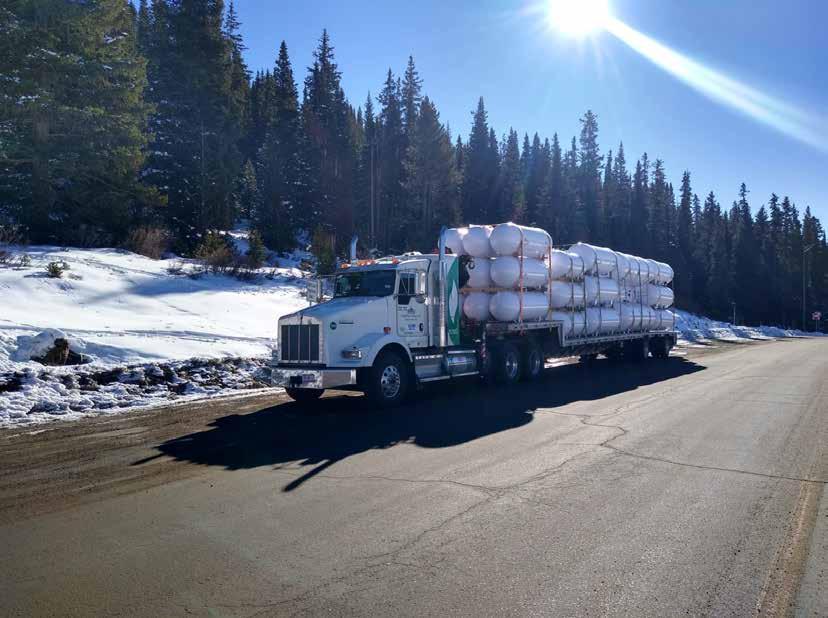
President: Allen Wells, Wells Propane, 281-332-2630
President Elect: Larry Baty, Cadenhead Servis Gas, 972-771-8654
Secretary: Harris Baker, HBH Systems, 512-587-8347
Treasurer/Finance Chair: Bill Collins, Propane Exchange, 214-629-5118
District 1 Director: David Collett, Gas and Supply, 903-780-2488
District 1 Alternate: Open
District 2 Director: Open
District 2 Alternate: Open
District 3 Director: Open
District 3 Alternate: Open
District 4 Director: Danny Meyers, Bellville Butane 979-865-2698
District 4 Alternate: Matt Peterson, Buster Brown Propane, 281-689-3946
District 5 Director: Brody Newton, Busters Propane, 361-852-8161
District 5 Alternate: Open
District 6 Director: Omar Garcia, Mr. G Propane, 956-581-1063
District 6 Alternate: Alex Hinojosa, Hino Gas Sales, 956-423-9178
District 7 Director: Sharon Seal, Bell Hydrogas, 210-533-7103
District 7 Alternate: Open
District 8 Director: Rodney Sladek, Fayetteville Propane, 979-836-7044
District 8 Alternate: Open
District 9 Director: Brad Quisenberry, Gene Harris Petroleum, 817-295-1091
District 9 Alternate: Larry Hearn, Yellow Rose Propane, 870-648-8241
District 10 Director: Josh Nowlin, McCraw Propane, 9003-583-7481
District 10 Alternate: Chad Gregg, Enderby Gas, 940-482-3225
District 11 Director: Steve Adams, Hardwick LPG, 254-647-3402
District 11 Alternate: Open
District 12 Director: Laci Jo Stone, Schneider Distributing, 800-901-9109
District 12 Alternate: Open
District 13 Director: Lane Worthington, WTG Fuels, 432-682-4349
District 13 Alternate: Casey King, WTG Fuels, 432-894-4240
District 14 Director: Terry Perez, Perez Propane, 512-318-9780
District 14 Alternate: Open
District 15 Director: Don Heinrich, Slaton Gas, 806-828-6501
District 15 Alternate: Open
District 16 Director: Mark Garrison, Fred Garrison Oil, 806-296-6353
District 16 Alternate: Open
Past President: Josh McAdams, McAdams Propane, 936-598-7444
Past President: Mark Peterson, Buster Brown Propane, 281-689-3946
Past President: Jack Walzel, Tri-Co Propane, 254-642-3885
Past President: John Walter, Schneider Distributing, 800-901-9109
Past President: Ben Wood, Northwest Propane, 972-247-6121
Vice President: Steve Adams, Hardwick LPG, 254-647-3402
Vice President: Jeremy Gentile, Hill Butane, 409-296-2001
Vice President: Matt Terry, Matador Gas, 210-861-6545
Sr. Vice President: Todd Dorris, Roadrunner Energy, 830-278-2915
Sr. Vice President: Bill Collins, Collins Propane, 972-442-1078
Sr. Vice President: Joe Green, Green’s Blue Flame Gas, 713-462-5414
Assoc. Supplier Service Director: Rusty Walker, Marshall Young 817-645 9155
Assoc. Supplier Service Alternate: Andy Brus, Crum & Forster 682-220-4812
Assoc. Producer/Marketing Gas Director: Jim Fulton, 4JEnergy 832-529-4768
Assoc. Producer/Marketing Gas Alternate: Open
Assoc. Manufacturer/Distributor Director: Joe Ezernack, Meeder Equipment, 903-877-9401
Assoc. Manufacturer/Distributor Alternate: Troy Hicks, Squibb Taylor 915-613-7534
Assoc. At Large Director: Crystelle Markley, Superior Energy Systems, 512-944-4177
Assoc. At Large Alternate: Jimmie Grant, Martin Gas Sales, 713-851-6155
Nominating Chair: Ben Wood, Northwest Propane, 972-247-6121
NPGA Director: Chad Gray, Dixie LP Gas, 254-582-5359








It's estimated that Texas is home to 17 percent of the world's crypto mining operations.
Texas’ regulatory climate, space and natural resources have attracted an outsized share of new crypto mining ventures. Federal regulators are starting to sound alarms about their energy consumption and their subsequent effects on the environment. The more the industry grows, the harder it is for new players to secure access to electricity or natural gas. The industry could be looking to diversify both its prime power needs and back-up power generation. Propane, already part of their energy package, could increase its role significantly.
Crypto. You’ve heard of it. You might still be on the fence about what it is. And to add a little more confusion to the topic, you can “mine” for the digital currencies. But this isn’t “mining” in the man-in-a-hardhatwith-a-canary sense. There’s not a mineral or resource that is the end goal. Crypto mining is using computers to solve complex algorithmic puzzles to earn currency. The main resource needed to run these complex banks of computers is electric power. And crypto mining has blossomed in the United States—and Texas specifically—in a big way.
The more the industry grows, the harder it is for new players to secure access to electricity or natural gas.
taxation on grid-based energy used for operations as high as 30 percent), which is leading the industry towards using alternate energy sources and being as nimble as possible to react to energy costs and potential policy changes.
Regulators are playing catch up with the ramifications of the free market access to what has been estimated by the U.S. Energy Information Administration (EIA) to be between 0.6% and 2.3% of U.S. electricity consumption. The EIA has been so alarmed at the rapid increase in electric consumption, and their lack of ability to track it, that it submitted an Emergency Request to the federal Office of Management and Budget (OMB) in January 2024 to require cryptocurrency miners to provide details of their energy use over the next several months.
“We intend to continue to analyze and write about the energy implications of cryptocurrency mining activities in the United States,” said EIA Administrator Joe DeCarolis. “We will specifically focus on how the energy demand for cryptocurrency mining is evolving, identify geographic areas of high growth, and quantify the sources of electricity used to meet cryptocurrency mining demand.”
The agency expects to publish more detailed information about their use of electricity in the U.S. in mid- to late 2024.
Before we delve into how propane fits into a crypto mining ecosystem, let’s back up and talk about the industry as a whole. Cryptocurrency mining began in the U.S. about a decade ago, but rapidly expanded in recent years.
The banks of computers used for the mining were shipped to countries more open to the efforts, and in particular states that were open to the business. Enter Texas, which has become one of the biggest destinations for crypto miners.
According to the Texas Blockchain Council, a nonprofit industry association working to make Texas the jurisdiction of choice for bitcoin, blockchain, and digital asset innovation, Texas represents 17 percent of the global bitcoin hashrate, which is the total combined computational power that is being used to mine and process transactions on a blockchain.
This rapid build-up has taxed access to “traditional” electricity. This is coupled with a very real threat of increased federal oversight (there has been proposed
According to Gavin Hale of the Propane Education & Research Council, “One of the most viable paths here is to bring energy generation close to the point of consumption, and propane fueled generator sets hold the key to a reliable, low cost, well supported solution. Propane is an abundant domestic energy source with a reliable supply from the 3,500 plus propane markers throughout the U.S.”
Meritum Energy’s Chris Hill noted that “Texas is really well supported here, with partners that can not only supply the fuel, but also the generators required to provide the on-site electrical energy.”
“The key here,” Hale continued, “is that propane offers a reliable supply of low emissions, and low fuel cost power generation solutions that are not part of the established electricity grid, thus safe from supply interruptions and potential taxation.”
Jessica Helsley, with Critical Power, a company that specializes in backup power and cooling equipment, says their company utilizes diesel, natural gas and propane in their installations. Frequently, the company retrofits natural gas generators to propane for crypto miners.
Often, the decision to use propane on a new installation isn’t economics in the way we are used to (price of propane). Rather it’s because the grid is so strained that new players either can’t get access to the grid, or it is much delayed. “We’re running into this everywhere,” Helsley said. “The grids can’t sustain this rapid growth.”
She says it’s not just crypto miners straining the system across the nation. It’s also big data centers, hospital systems and cannabis farmers. “And for crypto miners, it’s now, now, now. They can’t wait months or years for natural gas access. Every month they aren’t running, they are losing money.”

A cryptocurrency, crypto-currency, or crypto[a] is a digital currency designed to work as a medium of exchange through a computer network that is not reliant on any central authority, such as a government or bank, to uphold or maintain it.
Cryptocurrency does not exist in physical form (like paper money) and is typically not issued by a central authority. Cryptocurrencies typically use decentralized control as opposed to a central bank digital currency (CBDC).
The first cryptocurrency was Bitcoin, which was first released as opensource software in 2009. As of June 2023, there were more than 25,000 other cryptocurrencies in the marketplace, of which more than 40 had a market capitalization exceeding $1 billion.
Primarily from Wikipedia, the free encyclopedia

One of the most viable paths here is to bring energy generation close to the point of consumption, and propane fueled generator sets hold the key to a reliable, low cost, well-supported solution.
Helsley says that propane is better used with the smaller generator sizes, since the Derate increases as the generator size gets larger. For instance, a 100kW natural gas generator yields around 80kW on propane, but a 300kW natural gas generator yields around 150kW-200kW.
Paralleling generators, Helsley says, is a more efficient way to use propane for these generators. In addition to being a more efficient process for propane’s use, it mitigates risks associated with a single large generator failure and delivers several key advantages: enhanced redundancy, flexible load management, scalability, and improved efficiency.
“Mining loads aren't static,” Helsey said. “Paralleling allows you to activate additional generators only when needed, optimizing fuel consumption and reducing wear.”
Scott Mook with Evergreen Power, the company that created Juice Box (a propane to electricity generator) says that he’s seen some traction with crypto miners using Juice Box generators in their operations.
“Some of these facilities often operate under a 70 percent load, a common and optimal point for JuiceBox usage,” Mook said. “The machine uses around 2.3 gallons per hour of propane, making it a cost-effective alternative to diesel, as propane is half the cost and still comparable to gasoline.”
“When you deploy a JuiceBox at a cryptocurrency site, it powers both the crypto mining and the HVAC system. This ensures a consistent and economical energy supply, crucial for cooling the machinery.”
Could propane be used at larger sites? “Absolutely,” Mook said, adding that paralleling multiple units could be utilized for larger facilities, offering scalability.
Cryptocurrency mining facilities have gotten creative and have made use of a variety of strategies to manage their electricity cost. As it relates to Texas, miners have taken to utilizing flared gases and stranded gas. Flared gases refer to the waste methane that would have needed to flare or vent. Stranded gases represent wells that aren’t financially viable due to their lack of infrastructure/pipelines.
Just last year, the Texas Legislature passed HB591, which clarified that formerly flared or vented gas can be sold to on-site mobile data centers.
This has been a symbiotic partnership for some in the oil and gas industry, as the amount of allowable flared gas has dropped significantly in the past decade. The Texas Methane & Flaring Commission, which counts all of the major oil and gas associations and more than 40 producers as members, has been working toward its goal of ending routine flaring by 2030, the same date as the World Bank’s global goal.
In West Texas, this has become a large source of prime energy for crypto miners.
Chuck Justus, the creator and owner of Juice Box (Evergreen Power), a propane-to-electricity generator set, has been working with one oil and gas company on capturing the flared gas and turning it into electricity for the adjacent crypto mining client. While Justus calls it “propane adjacent”, referring to the fact that the flared gas isn’t propane, but a methane hydrocarbon mixture, he called it a win/win for all involved. The oil company didn’t flare the gases, and the crypto miners were able to convert it to usable energy while off-grid.
Another “creative” solution? Acquire the power generation facility. In mid-February, Hut 8, which among other things owns six Bitcoin mining locations, including in Texas, acquired four natural gas power generation facilities in Ontario, Canada totaling 310 MW in partnership with Macquarie Group Limited, a global financial services group.
Riot Platforms in Rockdale, Texas, claims to be the largest Bitcoin miner in North America, and represents the scale of industry here in the state. The company reported total revenue of $280.7 million in 2023, and it is scheduled to open a new Corsicana site this fiscal quarter that “when fully developed, will be the largest dedicated Bitcoin mining facility in the world.”
As cryptocurrency mining has increased in the United States, concerns have grown about the energy-intensive nature of the business and its effects on the U.S. electric power industry. Concerns expressed to EIA include strains on the electricity grid during periods of peak demand, the potential for higher electricity prices, as well as effects on energy-related carbon dioxide (CO2) emissions.

Bratcher with the Texas Blockchain Council said that there are more than 20 industrial-scale Bitcoin mining operations in Texas that can collectively consume up to 2,300 megawatts of energy a day. That is enough to power about 460,000 homes during times of high demand in Texas.
In Texas specifically, numerous stories have been written about the potential for mining to drive up electric prices for consumers and/or affect access to electricity in times of high demand, be that in the heat or deep freeze.
But Lee Bratcher, president of the Texas Blockchain Council, wrote in a recent press release that “Bitcoin miners are the economically perfect consumers of electricity.”
“That is not to say that bitcoin miners will consume electricity in an altruistic way, but rather that margins for bitcoin miners are uniquely sensitive to the price of power such that they are economically incentivized to curtail consumption when power prices exceed their breakeven threshold (current breakeven for most miners ranges between $100 and $200 per MWh). That means they will consume electricity when prices are below their breakeven price and turn off when prices are above it. There are some operational and practical exceptions to this, for example, if miners have data center colocation agreements that stipulate or guarantee uptime.”
Bratcher continued: “Texans should want bitcoin miners to be on anytime power is abundant because their consistent consumption incentivizes the buildout of additional generation. And less counterintuitively, we naturally want bitcoin miners to curtail when prices are high and the grid is under stress.”
Rural Texas has seen incredible action for crypto operators eager to take advantage of space, natural resources, and the state’s open regulatory environment. While exact numbers are hard to come by on how many operators are in the state, some of the biggest players include Riot Platforms in Rockdale and Corsicana; Cipher Mining in Odessa; US Bitcoin in Upton County; Rhodium Enterprises in Temple; and Bitdeer in Rockdale.
In an interview with the Texas Tribune in January 2024,
Propane marketers should be paying attention, as the market’s needs may be changing. Propane could very well be a bigger part of the industry’s future.

Blockchain: A digital ledger recording all cryptocurrency transactions, distributed across a network of computers.
Coin/Token: Digital units of value used on a blockchain.
Bitcoin: The first and most popular cryptocurrency.
Altcoin: Any cryptocurrency other than Bitcoin.
Fiat Currency: Government-issued paper money or coins.
Decentralization: No single entity controls the network.
Crypto Mining: The process of validating transactions and earning rewards.
Satoshi: The smallest unit of Bitcoin; 100 million Satoshis = 1 Bitcoin.
Wallet: A digital storage device for your cryptocurrency.
Exchange: A platform for buying, selling, and trading cryptocurrencies.
Market Capitalization: The total value of all a cryptocurrency in circulation.
Bull Market: A period of sustained price increase for cryptocurrencies.
Bear Market: A period of sustained price decrease for cryptocurrencies.

There’s a cleaner power solution on the horizon. In fact, it’s already here. Learn how propane and fuel cells can provide long-term resilience.
Backup power is becoming increasingly necessary during this time of grid instability, and thanks to advancements in technology, increasingly efficient.
Take the fuel cell. Not only can this product pitch in during outages, but it can also provide consistent power full time.
Unlike traditional standby generators, the fuel cell doesn’t combust fuel, it converts it into electricity. That means
quieter, cleaner operation, and near zeroemission backup power.
“The energy efficiency is two to three times that of a conventional generator,” says Dr. Yanhai Du, professor at the College of Aeronautics and Engineering at Kent State University. Dr. Du heads up the university’s Energy and Sustainability Research Team, exploring advancements in fuel cell technology.
The fuel cell is hardly new, dating back to the 1830s, but there’s renewed interest in it as many builders are considering alternatives to household generators, par-

ticularly the diesel-based variety, in efforts to decarbonize.
Diesel generators have long dominated the market as the go-to solution for emergency backup power. While reliable, these units present serious air quality concerns. Diesel combustion produces significant amounts of carbon dioxide, particulate matter, and nitrogen oxides. That’s why propane has emerged as a cleaner fuel source for backup power. Combined with fuel cell technology, propane offers a promising path forward.
While hydrogen is the future fuel for this technology, it is not available for domestic use, nor is it easy to transport or store. Propane is available and transportable.
“Propane is everywhere,” Dr. Du says. “It’s portable and easy to handle.” That means if fuel cells go mainstream, they’ll have an abundant and readily available fuel source.
Here’s what propane retailers need to know about fuel cells as an innovative solution:
They consume less fuel: Fuel cells convert gas into electricity through an electrochemical process, which means it does more with less propane. Ed Lieberman, vice president of sales at Upstart Power, maker of solid oxide fuel cell power systems, estimates its 1.25kW residential system can power the average 2,000-squarefoot home for 30kW hours with a third of the amount of propane a conventional generator would use. That means a 250-gallon propane tank can last nearly 50 days, as opposed to 15. “When you use fuel, you’ll sip it, not drink it,” Lieberman says.
They are compatible with batteries and solar: Many homeowners can only use their generators as a last resort, preferring to lean on renewable energy like solar. A hybrid energy system, which uses a combination of clean power sources and standby power, provides resilience with minimal fuel consumption: Solar panels supply a home’s electrical demand while storing surplus electricity in a battery. During a blackout, or at night, the battery can serve as the primary power source.
When it drains down, the fuel cell kicks on — a backup to the backup power. “If you need long-term resilience, that’s when you’re going to use fuel,” Lieberman says. The advantage of propane appliances like water heaters, furnaces, clothes dryers and cooktops is that they reduce electrical demand on the system, helping a battery last even longer.
They are compatible with CHP: While a fuel cell can keep the lights on during a blackout, it also has to the potential to supply space and water heating. A combined heat and power system (CHP) can capture heat energy generated by the fuel cell to help maintain home comfort, Dr. Du says.
They are quiet: Internal combustion engines can be noisy. When the power goes out in a neighborhood, the rattling and hum of generators can be a nuisance. Fuel cells, on the other hand, are almost whisper quiet. Lieberman compares their sound profile to that of a refrigerator. The silent operation “makes better neighbors,” he says.
They require near zero maintenance: Internal combustion engines have a lot of moving parts, which means you’ll occasionally need to change spark plugs and oil to keep them operational. Fuel cells are minimal hassle. Plus, the appliances can be wall-mounted to keep them above water during a flood.
They are already here: Fuel cell technology is the technology of the future, and it’s available now. There have been several high-profile commercial cases, such as Microsoft’s 3MW hydrogen fuel cell backup power plant, but fuel cells are catching on residentially, as well, Lieberman explains. Upstart Power’s residential units will be available this year. “We’ve already had back orders for thousands of units,” he says.
Dr. Du likens fuel cells to solar panels. “Twenty years ago, solar panels were a luxurious thing,” he says. What was once prohibitively expensive for many is now fairly common. He estimates fuel cells will have a similar trajectory, with widespread adoption of the technology when costs go down.
In its recent report, WLPGA future expands on the potential market opportunities for Liquid Gas fuel cells
Residential and small scale combined heat and power (CHP): Liquid Gas can fuel cells can be used in residential settings for CHP applications. These systems provide both electricity and heat for space heating or water heating, offering high efficiency and potential energy cost savings for homeowners.
Backup Power Systems: Liquid Gas fuel cells can be used as backup power systems for critical infrastructure, such as data centres, hospitals, and other facilities. They provide a reliable source of power during grid outages.
Auxiliary Power Units (APU)s: APUs provide onboard electricity and heat in various applications. APUs are secondary power sources, typically used in vehicles, aircraft, and other mobile or stationary settings, to supply electricity, heat, or air conditioning independently of the main power source.
Commercial and Industrial CHP: Liquid fuel cells can be integrated into CHP systems to provide electricity and heat for various processes.
Remote and Off Grid Areas: In remote or off-grid areas where access to


conventional power sources is limited, Liquid Gas fuel cells can serve as a reliable and independent power solution. This includes applications in remote telecommunications towers, research stations, or rural electrification projects.
Telecommunication Infrastructure: Liquid Gas fuel cells are used to provide backup power for telecommunication towers in areas with unreliable grid power. The reliable and continuous power supply is crucial for maintaining communication services.
Forklifts or Material Handling Vehicles: Liquid Gas fuel cells can be integrated into material handling equipment, such as forklifts and warehouse vehicles. This application offers advantages over traditional lead-acid batteries, including faster refuelling times and longer operating hours.
Recreational Vehicles (RVs) and Boats: Liquid Gas fuel cells can be employed in RVs and boats as a clean and efficient power source for on-board electrical systems. They offer a quieter and
more environmentally friendly alternative to traditional generators.
Portable Power Systems: Portable Liquid Gas fuel cells are used for various applications, such as camping, outdoor events, and emergency situations. These compact systems provide a convenient and clean power source in locations without access to traditional electricity.
Modified from its original version published by the Propane Education & Research Council (PERC).



DOWNLOAD REPORT
Download the recent extensive Fuel Cell report from WLPGA. The report covers the different types of fuel cell technologies and how they work and digs deeper into each market. Report can be downloaded at https://www.worldliquidgas.org/ publications/.
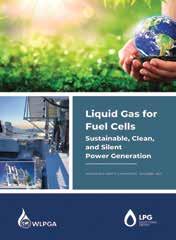

Just over a decade since the formation of the Texas Butane Dealers Association (TBDA), the Texas Propane Gas Association looks back on 1955. In 1955, the TBDA leadership torch was handed to Paul Thompson of Federal Petroleum. The name might seem familiar as Paul is grandfather of current Railroad Commission Safety Specialist Kent Thompson.
Paul spearheaded several initiatives during his TBDA Presidency, including strengthening the Association’s Rules and Regulation Committee, which was formed to audit and request changes to propane industry rules and regulations. This was called Docket 1 and is now known as the Texas LP Gas Safety Rules.
In an effort to help its members with compliance, the TBDA Industry Improvement Committee chaired by J.B. Wood of Northwest Butane Company, father of TPGA member, Jay Wood of Northwest Propane, approved the association starting sales of propane decals and signs to help dealers meet RRC requirements.
On the national front, the Texas Butane Dealers Association was reporting on the resiliency of LP-Gas in nuclear impact testing.
“In the spring of 1955, as the Cold War intensified and the arms race between the United States and the Soviet Union escalated at a shocking pace, America—as it had many times before—detonated an atomic weapon in the Nevada desert,” reported Life Magazine.
Unlike previous tests by the Atomic Energy Commission, the primary objective of Operation Cue, part of the Teapot series, was not weapons development but rather an assessment of the impact of an atomic blast on everyday infrastructure, including homes, utilities, vehicles, and crucially, Liquefied Petroleum Gas (LP-Gas) systems. This experiment provided valuable insights into the resilience of infrastructure and informed preparedness measures for the Cold War era.
Texas Butane News, the association’s publication at the time, reported that reporters were primed to be shocked when they arrived at the testing site, having witnessed the fireball dwarf the tiny test village and felt its punch eight miles away. However, the first things they noticed were what survived the blast – shelved groceries and a 15,400-gallon LP-Gas tank remained intact, with only its handrail bent.

The results of Operation Cue nuclear testing also evaluated the impact on three types of LP-Gas containers and systems at various distances from ground zero. The bulk storage tank at 4,700 feet remained operational with minor damage, and the cylinder filling building was destroyed but could quickly resume emergency filling. Dual cylinder systems suffered damage at closer distances but were mostly salvageable, with no damage at 10,500 feet. 500-gallon tanks suffered minor repairable damage even at close distances and were operational at 10,500 feet. Many gas appliances were operable with minor repairs at 4,700 feet and usable in houses with minimal structural damage at 10,500 feet and underground gas lines to houses less than a mile from ground zero were undamaged.
The report from the Federal Civil Defense Administration concluded that LP-Gas could be a reliable source of fuel even after a nuclear explosion, especially for areas with underground storage and minimal structural damage, providing a crucial perspective on post-disaster recovery.
Sources: Texas Butane News and Defense Technical Informational Center report: Cue for Survival. Operation Cue






The need for power generation – both primary and backup – is at the top of the list of new gallon sale opportunities in the New Year.
Propane already is playing a key role in the utility and power generation industry with generators and microgrids that offer the cleanest alternative energy for prime and backup power. In particular, propane generator solutions are being used in remote, wildfire-prone locations like California where electric utilities are deenergizing the transmission and distribution lines and installing microgrid solutions to avert forest fires.
Mobile power generation and electric vehicle (EV) charging are two other key applications where propane solutions are changing the game.
Mobile power generation provides resilient energy that helps protect businesses by combatting increased electric grid instability. Diesel generator sales have soared due to electric grid disturbances caused by heightened severe weather events, exacerbating local air quality concerns. Propane can displace those dirty diesels and significantly improve local air quality by mitigating nitrogen oxides and particulate matter emissions.
The flexibility of propane offers ideal
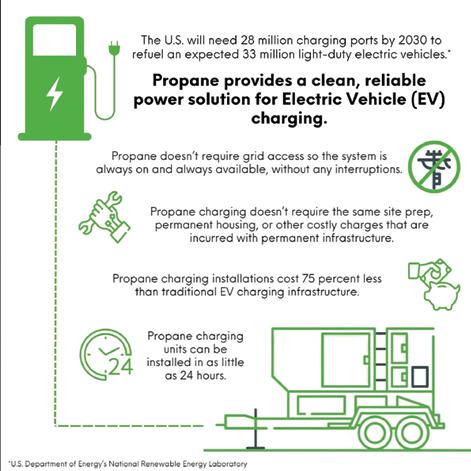
power solutions in remote locations targeted for new construction, as well as at sites that aren’t supported by adequate infrastructure.
When the grid fails, electric vehicle fleets are indefinitely grounded from servicing delivery routes. Propane’s clean, reliable power solutions can recharge fleets with DC level 3 fast chargers independent of the grid.
A portable propane skid solution is significantly less expensive than traditional EV charging infrastructure since it doesn’t require the same site prep, permanent housing, or other costly charges that are incurred with permanent infrastructure. It’s fully portable, scalable, runs reliably regardless of the weather, and can be installed in as little as 24 hours.
“As an industry, we’re not just limited to
just those two applications. We know that propane-powered equipment can be the solution for businesses, fleets, farms and homes across the country to provide scalable solutions that are clean, reliable and affordable,” says PERC President Tucker Perkins.
“We have technology today to power EV charging stations, both mobile and stationary prime power, as well as backup power and standby generators for homes, farms and businesses. I encourage you to become familiar with your current customers’ needs for electricity demand as well as backup power and investigate how propane can be a solution.”









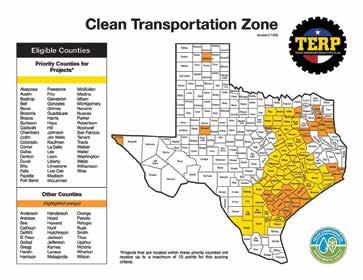
The Alternative Fuel Facilities Program (AFFP) provides grants for construction or upgrade of alternative fuel refueling station including propane.
Station Type. Eligible facilities that will be open to the public will be considered for funding before private facilities.
Grant Amounts. Covers 50% of eligible expenses up to $600,000
Eligible expenses include planning, designing, engineering, dispensing equipment and storage tanks, supplies, construction, contractors and subcontractors.
Project costs not eligible for reimbursement include insurance premiums, salaries, and travel expenses for grantee employees. Costs related to the preparation and submission of the grant application, administrative expenses (e.g., office supplies, rent, marketing, advertising), and facility improvements or equipment not directly linked to storing, compressing, or dispensing alternative fuel are excluded. This also applies to purchasing existing alternative fuel facilities, structures, land, or interests in land. Moreover, permitting costs for TCEQ-issued permits and non-arms-length transactions (e.g., using

existing inventory without proof of purchase or transactions between affiliated companies) are not eligible.
Eligible Areas. Alt Fuel stations located in counties called the Clean Transportation Zone can apply.
Scoring. Grant is not first come, first serve. It’s competitive. Applications scored by station location (proximity to highway); project objectives, applicant qualifications, & project feasibility.
Deadline. The competitive grant deadline is March 22, 2024.

Project completion. Awardees have until April 30, 2026 to complete new station construction or upgrade.
Reporting. Grant winners will be required to provide a quarterly progress report until station is completed. Once completed, a final report with pictures will be required. Thereafter for three years, an annual report will be due.
Learn more about the program at https://www.tceq.texas.gov/airquality/ terp/affp.
Complimentary grant writing assistance is available from the American Energy Institute in partnership with the Propane Council of Texas (ProCOT). Contact Heather Ball at heather@ americanenergyinstitute.com to see if you might be a good candidate for the competitive grant.



Since 1997, the TPGA Scholarship Foundation has dedicated itself to providing scholarships for exceptional students who will be pursuing higher education. Over the last nearly three decades, TPGA has awarded over $200,000 in scholarships. TPGA is awarding higher education scholarships for the upcoming 20242025 academic school year.
Scholarship award checks are mailed over the summer directly to your educational institution to be applied to tuition and fees and room and board for the academic year. The full award can be applied fully to the fall 2024 semester or divided between the fall 2024 and spring 2025 semesters.
• Has not previously been awarded a scholarship by the TPGA Scholarship Foundation;
• A Texas high school senior or an undergraduate student who completed high school in Texas;
• Plans to be a full-time student for the upcoming 2024-2025 school year in an undergraduate degree program by an accredited college or university or enrolled in a vocational or technical school;
• A child or grandchild of an employee of a current member of the Texas Propane Gas Association in 2024;
• The parent’s or grandparent’s work must be directly related to the Texas propane industry; and
• GPA (need to be in the upper half of class for consideration).
All eligible students must submit our TPGA scholarship online
application to be entered into the scholarship competition. All required documents can be uploaded directly to the online application.
Completing the NPGA scholarship application will not automatically enter them into the Texas scholarship round. Students must complete the TPGA scholarship application to be entered into the Texas competition.
The deadline to submit all applications, including all required documents, is by 11:59 PM CDT on May 15, 2024.
Access the scholarship application at https://www.txpropane.com/scholarship.
If the application is successfully completed, the applicant will get an email confirmation.
What information will the student need to complete the scholarship application?
The application includes a short essay question.
In addition, the application asks for:
• The name of the TPGA member company of your parent’s or grandparent’s employer;
• Household financial information;
• Information about your extracurricular and community activities;
• Employment history (if applicable);
• ACT or SAT test score report (which can be uploaded directly to the online application); and
• An academic transcript (which can be uploaded directly to the online application).
How are winners selected?
TPGA scholarships applicants are thoroughly reviewed, scored, ranked, and selected by a third-party organization specializing in higher education, independent from the association. Applicants are scored based on financial need, academic rigor, extracurricular/community involvement, and writing through a short essay.
Scholarship winners will be notified in the summer of 2024. Learn more or donate at https://www.txpropane.com/scholarship.
Questions? Please contact the Texas Propane Gas Association Scholarship Foundation at (800)325-7427 or at tpgascholarship@txpropane.com.







Imagine this: a chilly winter evening, your customers are relying on your propane deliveries to stay warm. Suddenly, your systems are locked down, customer data is compromised, and chaos reigns. This isn’t just a nightmare scenario; it’s a growing reality for small businesses like yours in the propane industry.
Think you’re too small to be a target? Think again. Cybercriminals often view smaller businesses as easier prey, lacking the robust security measures of larger corporations. But fear not, propane warrior! With a few proactive steps, you can turn up the heat on cyber threats and protect your business.
Forge an Impregnable Shield:
• MFA is your double lock: Imagine needing not just a key, but also a fingerprint scan to enter your office. Multi-Factor Authentication (MFA) does the same for online accounts. Make it mandatory for everyone, from the delivery team to accounting.
• Patch it: Just like a leak can lead to a big problem, unpatched software vulnerabilities can be exploited by attackers. Patch regularly, and don’t let outdated software become your weak spot.
• Passwords stronger than steel: Weak passwords are like flimsy locks –easily picked. Enforce strong password policies, with a mix of uppercase, lowercase, numbers, and symbols. Remember, sharing is not caring (especially when it comes to passwords!).
• Antivirus: Your digital defender: Don’t underestimate the power of a good antivirus and anti-malware program. Think of it as a security guard constantly monitoring your systems, deflecting malicious attacks.
Protect Your Precious Data:
• Encryption: Like a vault with a secret code: Sensitive data, like customer information and financial records, deserves top-notch protection. Encrypt it, both when stored and transmitted, making it unreadable to prying eyes.
• Access control: Not everyone gets a key: Limit access to data based on job roles. Why give the delivery driver the key to the accounting vault? Implement rolebased access controls to keep sensitive information secure.
• Backups: Your safety net in case of disaster: Imagine a fire at your office; you’d have backups of your valuables, right? Regularly back up your data securely offsite, so even if a cyberattack hits, you can restore your critical information.
• Data breach plan: Be prepared for the worst: Just like having a fire escape plan, have a data breach response plan in place. This outlines how you’ll respond to a breach, from notifying customers to cooperating with authorities.









Phishing: Don’t click on suspicious links: Phishing emails are like bait-filled emails hoping to catch you off guard. Train your employees to identify suspicious emails, links, and attachments. Knowledge is power in the fight against cybercrime.
• Best practices: Your digital armor: Equip your employees with the knowledge and tools to fight cyber threats. Train them on best practices like secure browsing, password hygiene, and reporting suspicious activity. They’ll be your front line of defense.
• Social engineering: Don’t be tricked: Social engineering scams come in many forms, from fake phone calls to impersonators. Train your employees to be wary of unsolicited requests for information or access, and to verify everything before acting.
Seek Help from the Experts:
• IT security consultant: Your digital advisor: Just like a trusted advisor, an IT security consultant can assess your vulnerabilities and create a customized security plan for your business.
• Managed Security Service Provider (MSSP): Your digital partner: Consider outsourcing some of your security needs to an MSSP. They’ll be your watchful guardians, constantly monitoring your systems for threats.
Stay Vigilant, Like a Watchful Guardian:
• Industry alerts: Stay ahead of the curve: Subscribe to industry alerts and resources to keep up-to-date on the latest cyber threats targeting the propane industry. Knowledge is power when it comes to defense.
• Industry associations: Join forces with others: Collaborate with other propane businesses through industry associations. Share best practices, learn from each other’s experiences, and build a stronger collective defense.
By following these steps, you’ll transform your propane business from a vulnerable target into a secure and resilient operation. Remember, cybersecurity is an ongoing process, not a one-time fix. Stay vigilant, adapt your defenses, and you’ll ensure your business stays fueled for success, not consumed by cyberattacks.
Collaborate with other propane businesses through industry associations. Share best practices, learn from each other’s experiences, and build a stronger collective defense.
Bonus Tip: Consider cyber insurance as a shield against the financial fallout of a breach. And remember, communication is
key – keep your employees and customers informed about your cybersecurity efforts to build trust and transparency.

Isn’t it time to trust that your insurance works as hard as you do?
John
President
• You will be educated about your policy coverages and shown where you might be vulnerable.
• You will receive multiple options for your insurance.


Last year, the Propane Education & Research Council (PERC) added 15 new courses and resources to its The Learning Center online at https:// training.propane.com/ that will help keep your employees and customers safe and keep your businesses running.
• Lighting Appliance Pilots: Large Commercial & Industrial Module
• Gas Appliance Startup Program
• Conducting Gas System Performance Testing Program
• Purging Gas Piping Systems Program
• Conducting a New System Interior Site Assessment Program
• Regulator Operations: Large Commercial & Industrial Module
• Propane Emergencies: Propane Operations Course
• Propane Emergencies: Propane Operations Accompanying Hands-On Course
• Propane Autogas Vehicle Inspection Program
• Propane Container Sizing and Selection Module
• Determine Total Connected BTU Load Program
• Installing Propane Containers Program
• Propane Mower Safety Guide
• Sizing and Selecting Propane Vaporizers Module
Take some time to review the new courses and resources that were added in 2023 and ensure all your employees have access to the information they need to safely do their jobs.

Bobby Charles Baze, 92, passed away Feb. 2, 2024. He established Bob Baze Propane, LLC in Grandview, Texas, in 2006. Bobby was one of 13 children. He was preceded in death by his parents, 12 brothers and sisters, his wife of over 55 years, Edna Mae Baze, and his oldest son, Charles Kenneth Baze. He is survived by his son, Michael Lynn Baze and wife Sherry. Daughter, Paula Jean Hunter and husband Rick, among others. Our thoughts are with the Baze family.

Jackie Smith Lofland, 72, of Richards, passed away Jan. 11, 2024. Jackie was the sweet voice and face that greeted you at Triangle B Propane and Hardware Store for many years. She loved animals and would always take in any animal in need of help. Jackie will be greatly missed and may she rest in peace.

With the closure of the federal EPA Clean School Bus Program, the Texas Clean School Bus (TCSB) Program from the Texas Commission of Environmental Quality is now open.
The TCEQ is currently accepting applications for the Texas Emissions Reduction Plan (TERP) TCSB program. Grants are available statewide to public school districts, open-enrollment charter schools, and transportation systems provided by a county-wide school district that operate diesel-fueled school buses in Texas to replace or retrofit school buses operating on a regular daily route to and from school.
Grant applicants can be reimbursed up to 80% of the cost to replace pre2007 diesel-fueled school buses with newer, cleaner models like propane powered clean school buses.
While the application deadline is October 14, 2024, this is a first come, first requested program, funds are usually all applied for within 6 weeks.
Grant application forms and additional program requirements are available on the TCSB webpage at https://www.tceq.texas.gov/airquality/ terp/school-buses.html
If a school district needs help applying, they can reach out to our partner, the American Energy Institute. They can help them with all their grant paperwork and submission. The institute can be reached by contacting Heather Ball at 512-484-8535 or by email at heather@americanenergyinstitute.com.
Have questions? Contact TCEQ toll-free at 800-919-TERP (8377) or by email at terp@tceq.texas.gov with any questions. For more information, visit our website at www.terpgrants.org.

For businesses that use or intend to use propane commercial mowers, propane safety is paramount. Considerations include the propane container, the components, and the method by which the container is filled and stored.
Visit https://propane.com/for-my-business/ landscape-and-turf-management/safety/ and share the Propane Mower Safety Guide from the Propane Education & Research Council (PERC) and help ensure the continued safe use of propane commercial mowers.
Outdoor living will remain a large focal point for builders in the year ahead with amenities such as propane fireplaces and patio heaters.
Activities commonly associated with being indoors are expected to move outdoors. Watching TV, playing games and hosting friends outside is what the TurfMutt Foundation calls “backyarding” and it’s expected to be a major focal point for builders in the year ahead.
To accommodate these activities, builders can anticipate demand for screened-in porches with propane patio heaters. Features like these allow homeowners to spend time outdoors well into the fall.
“Now more than ever, homeowners are recognizing the power of their yards and parks doing environmental good, as well as benefiting their health and well-being,” says Kris Kiser, president and CEO of the TurfMutt Foundation and its parent organization, the Outdoor Power Equipment Institute. “Homeowners are making improvements in their yards with many goals in mind, thinking about what’s good for their families, pets, and our planet.”
Meanwhile, Houzz has chimed in with predictions of its own — among them, outdoor gathering areas.“Professionals on Houzz are increasingly adding outdoor gathering
areas that can help maximize living space and create a more dynamic home entertaining experience. Anchoring the area with a feature like a fireplace or a fire pit, a bar, or an outdoor TV creates a focal point and draws guests out into the yard,” Builder reports.
Amenities such as fire pits, fire tables and tiki-style torches add warmth and ambiance to any backyard. These features are a relatively easy add-on with propane, eliminating the need to tap into a natural gas line.
Story compliments of the Propane Education & Research Council (PERC)
https://www.gyxis.jp/eng/
https://matrixcmg.com/








5-6
TPGA Board & Committee Meetings
Bee Cave, TX
11- 13
Technology, Standards & Safety Committee Meeting
Hilton Head, SC
15
TPGA Scholarship Opens
14-15
Benchmarking Spring Meeting
Houston, TX
22
TERP Light Duty Vehicle Incentive Program Deadline
22
TCEQ Alternative Fuel Facilities Program Grant Deadline
29
TPGA Office Closed for Good Friday
APRIL
5 - 7
2024 Southeastern Propane Expo Charlotte, NC
24 - 25
PERC Council Meeting Hot Springs, VA
MAY
9- 10
PERC Advisory Council Meeting Cleveland, OH 15
TPGA Scholarship Deadline 27
TPGA Office Closed for Memorial Day





